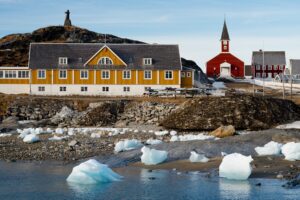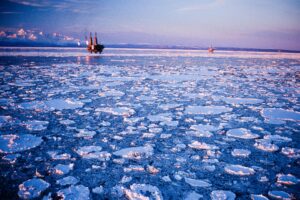The Russian economy is dominated by the extraction of natural resources, primarily oil and natural gas. The country is the world’s third-largest producer of hydrocarbon resources and more than 50 percent of Russia’s federal budget depends on revenue derived from oil and gas production. Russia’s Arctic and sub-Arctic regions account for 90 percent of Russia’s natural gas production and 10 percent of its oil production. However, in recent years, Russia has hit a record high in natural gas production. A total of 3.5 billion rubles were invested in the Russian energy sector in 2017, 10 percent more than previous years. Natural gas production in 2017 amounted to the highest volume in 17 years, while exports also peaked. The new Bovanenkovo field in the Yamal Peninsula will produce a record-high 115 billion cubic meters by 2020.
History of Oil and Gas in Russia’s Arctic
The exploitation of oil and gas in the Russian Arctic dates back to the early 1930s. In 1930, the Arctic’s first oil field, Chibyuskoe, was discovered in the Republic of Komi followed by the Yarega oil fields in 1932. Some of Russia’s largest oil and gas fields, which are still in production today, were discovered during geological prospecting in the 1960s and 1970s. Development focused on the West Siberian oil and gas province, and more specifically the Arctic part of the province known as Yamalo-Nenets Autonomous Okrug (YaNAO).
A number of giant natural gas fields surpassing any previously known has fields in scope and size were discovered in YaNOA starting with the Tazovskoe field, followed by the Novoportovskoe oil and gas condensate field in 1964, the Gubkinskoe oil and gas condensate field and the Zapolyarnoe gas field in 1965, the Urengoy oil and gas condensate field in 1966, the Medvezhye gas field in 1967 and the Russkoe oil field in 1968.
Additional developments followed in the 1970s and 1980s in the northeastern part of the West Siberian oil and gas province along the lower reaches of the Yenisei River with the discovery of the Vankor, Tagul, Lodochnoe, and Suzun fields. During the 1970s and 1980s development followed on the Yamal peninsula with the discoveries of the Bovanenkovskoe gas field in 1971, the Kharasavey and South Tambey fields in 1974, and the Rostovtsev oil and gas field in 1986. To this day YaNAO part of the West Siberian oil and gas province remains the largest gas-producing region of the world and also provides substantial share of Russia’s oil production.
In 2010, Norway and Russia resolved a 44-year dispute over the border delineation in the Barents Sea. The countries agreed to split the 175,000 square kilometre area under dispute which may contain up to 4 billion barrels of oil and 878 trillion cubic feet of natural gas. The implementation of Western sanctions by the United States and the European Union against Russia impact the exploration and development of hydrocarbon resources in the Arctic. ExxonMobil signed a cooperation agreement with Rosneft for a total of 10 joint ventures, primarily exploration in the Kara and Black Seas as well as the joint development of the Bazhenov shale in West Siberia.
Following the sanctions, ExxonMobil was required to suspend its activities in the joint ventures. This follows the announcement from September 2014 of the successful discovery of petroleum resources at the Kay 1 well in the Kara Sea. Similarly, in June 2015 French energy company Total withdrew from a joint venture with Russia’s Lukoil under which they had planned to develop the Bazheno shale oil fields in West Siberia. The company also chose to return to Gazprom a 25 percent share it held in the postponed Shtokman gas field. Not affected by western sanctions is the development of the world’s first ice-resistance oil platform Prirazlomnoye which Gazprom constructed in the Pechora Sea. Production of oil began in April 2014.
Russian Cooperation with China
In 2014, Russian energy giant Gazprom and the CNPC signed an agreement that shipped gas from the Russian Arctic to China. The deal was worth about $400 billion. Although Europe remains Russia’s largest energy export market, Russia is using such deals to diversify gas trading partners with Asian countries.
The Yamal LNG project is arguably the most remarkable example of China’s cooperation with Russia in the Arctic. The Yamal LNG is a gas plant in the Russian Arctic which is estimated to hold 22 percent of the world’s gas reserves. Chinese entities provide financing and hold large stakes in the project. In 2013, Novatek and the China National Petroleum Corporation (CNPC) signed a contract that gave a 20 percent stake of the Yamal LNG project to China’s Silk Road Fund (SRF). The contract includes an agreement to ship more than 3 million tons of LNG every year to China.
In July 2018, Novatek delivered the first LNG cargo shipment via the Northern Sea Route (NSR) to China. Novatek head Leonid Mikhelson said that “utilizing the Northern Sea Route as a viable transportation route contributes to the development of the northern regions and is very important for [the] country’s economic development.” At the moment, the CNPC and SRF together own about 30 percent of the Yamal LNG project. Novatek owns 50.1 percent and French energy giant Total owns 20 percent. Chinese media celebrate the Yamal LNG as a “milestone in China-Russia cooperation” under the framework of the Belt Road Initiative (BRI). It is China’s first major Arctic energy project as part of its development strategy. The CNPC and SRF are now considering joining the multibillion-dollar Arctic LNG-2 project, set to be launched in 2023.
Northern Sea Route
Development of the Northern Sea Route (NSR) began in June 1936 when the Council of People’s Commissar of the former USSR established the Chief Directorate of the Northern Sea Route (Glavsevmorput). The Directorate was tasked with establishing and developing a route from the Barents Sea to the Bering Strait. Its task encompassed the establishment of sea, river and air transportation routes, the required telecommunications infrastructure and the leading of all Soviet research efforts in the Arctic. Furthermore, it also spearheaded the development of natural resources in the Arctic and the construction of required production facilities. In addition, it was also in charge of the promotion of the economic development of the indigenous peoples of the Arctic. The Northern Sea Route has since grown to be of the highest importance in national and regional development plans.
Following the end of the Cold War, many of the routes of communications deteriorated and associated infrastructure fell in disrepair with the decreasing use of the NSR. Cargo traffic decreased by nearly 90 percent during the 1990s compared to the early 1980s. With the onset of increasingly ice-free summer seasons, especially after the record melt season of 2007 and 2012, the NSR began a revival as a national and international transport corridor. While volumes remain very limited in comparison to global shipping hotspots like the Suez and Panama Canal, the route nonetheless is of key importance for the economic development of the Russian region situated along the route and the accessing, exploitation, and exporting of hydrocarbon resources in the Arctic.
In 2018, President Putin signed a decree which states that the NSR is to be developed continuously with annual goods volumes set to increase to 80 million tons by 2024. This is an 8-fold increase compared to 2017. This ties into Russia’s national strategy which emphasizes the development of the NSR into a global and comprehensive transport artery. Only 5 months after the Yamal liquefied natural gas (LNG) project in Northern Russia opened, volumes of shipment had exceeded two million tons of LNG. Another substantial goods increase on the NSR is coal. According to VostokCoal, 30 million tons of coal can be extracted annually by 2025 from the Taymyr Peninsula. Furthermore, a Maersk vessel loaded with Russian fish and South Korean electronics has become the first ship to fully navigate an Arctic sea route. Russia hopes this will become its new shipping highway, cutting transport times from Asia to Europe significantly by avoiding the Suez Canal. The NSR is still not a viable and sustainable option for most shipping businesses, as the passage is only feasible for 3 months of the year.
In 2020, the world’s first floating nuclear power plant Akademik Lomonosov has also been designed for the Arctic, and used by Rosatom. This is a new type of infrastructure used in Arctic waters, and supposed to supply electricity for remote Russian settlements.


